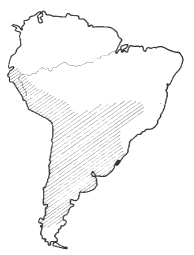English Name:
-Pampas fox, Argentine gray fox (10 (?) varieties )
other names
-Fr: Renard d'Azara
-Pampasfuchs
Group
-Dusicyon(Kamp-Foxes)
Lathin Name:
-Dusicyon gymnocercus
appearance:
-Shape and Size Foxlike. Fur short, dense, yellow-brown, downside lightened.
-Like the Red Fox, but usually somewhat smaller, fur predominantly gray
-Body length: 26 in; 65 cm
-Tail length: 12 in; 30 cm
-Shoulder height: 16 in; 40 cm
-Weight: 7-13 lb; 3-6 kg
-Pampas foxes resemble red foxes, but they are somewhat smaller with more
of a grayish coloration.
Geographic Range:
-Southamerica southern of the Äquator.
-habitat extends from southern Argentina and Chile to Uruguay, Paraguay,
and southern Brazil and on the west coast of South America as far as northern
Peru

Habitat:
-in open or semi-open country, nearly treeless pampas, hilly bush-covered steppes, semi-arid regions, and valleys in the foothills of the cordilleras.
Behaviour:
Activity: dusk and at night (In sparsely populated regions some are
active all day long)
-form pairs during the breeding season
-The deserted dens of armadillos and visaccias are used as shelters, as
are hiding places among the tree roots or in the clefts of rocks.
-Pampas foxes are, however, quite capable of digging their own dens.
-The young are reared by both parents for a certain period;
-clan groups undertake communal hunting.
-Apart from these times, pampas foxes are solitary creatures
-Many pampas foxes follow civilization.
-They enter villages at night, search through refuse heaps, steal poultry,
and look for food in orchards and vegetable gardens.
-They even use barns and deserted buildings as places for hiding, resting
or sleeping.
-Pampas foxes are not very quick.
-They flee in a zigzag path and skillfully use high grass and bushes as
cover.
-They mark their territory with urine throughout the year.
-Their repertory of sounds includes barking, howling, throaty growling,
and snorting.
-Varying degrees of tail motions are used to express different moods; a
horizontal tail posture signifies dominance.
Reproduction
-Gestation period: 2 months
-Young per birth: 3-6
-Birth time: Oct. or Nov.
Food Habits:
-Small mammals, birds, reptiles, amphibians, plants, fruits
-small mammals, birds, lizards, eggs, frogs, fish, shrimp, insects, and
other invertebrates.
-The proportion of vegetable food is high, including almost all field crops.
-Carrion, particularily from sheep and oxen, is also eaten.
Specialities :
-
others :
-Probably not endangered
-some legal protection, but, each year, many thousands of pelts are illegally
shipped from Brazil, Uruguay, Paraguay and Argentina.
-These animals are pursued by humans and their dogs, primarily for the
fur. They are kept in zoos in South America without difficulty.
- General Info about all Kamp-foxes